AMD Carrizo Part 2: A Generational Deep Dive into the Athlon X4 845 at $70
by Ian Cutress on July 14, 2016 9:00 AM ESTMiddle-Earth: Shadows of Mordor
The final title in our testing is another battle of system performance with the open world action-adventure title, Shadows of Mordor. Produced by Monolith using the LithTech Jupiter EX engine and numerous detail add-ons, SoM goes for detail and complexity to a large extent, despite having to be cut down from the original plans. The main story itself was written by the same writer as Red Dead Redemption, and it received Zero Punctuation’s Game of The Year in 2014.
For testing purposes, SoM gives a dynamic screen resolution setting, allowing us to render at high resolutions that are then scaled down to the monitor. As a result, we get several tests using the in-game benchmark, taking results as the average and minimum frame rates.
For this test we used the following settings with our graphics cards:
| Shadow of Mordor Settings | |||
| Resolution | Quality | ||
| Low GPU | Integrated Graphics | 1280x720 | Low |
| ASUS R7 240 1GB DDR3 | |||
| Medium GPU | MSI GTX 770 Lightning 2GB | 1920x1080 | Ultra |
| MSI R9 285 Gaming 2G | |||
| High GPU | ASUS GTX 980 Strix 4GB | 1920x1080 3840x2160 |
Ultra Ultra |
| MSI R9 290X Gaming 4G | |||
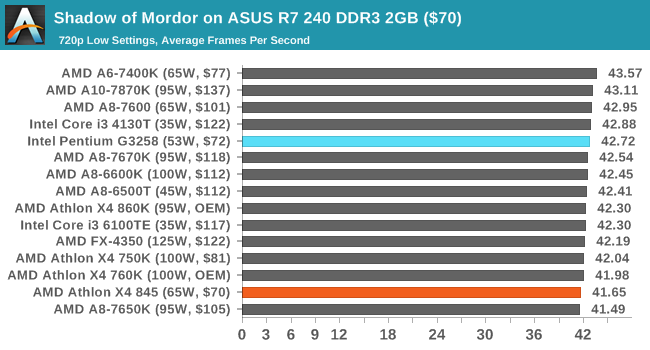
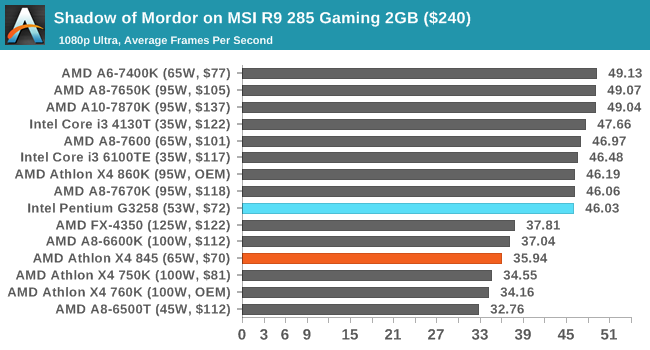

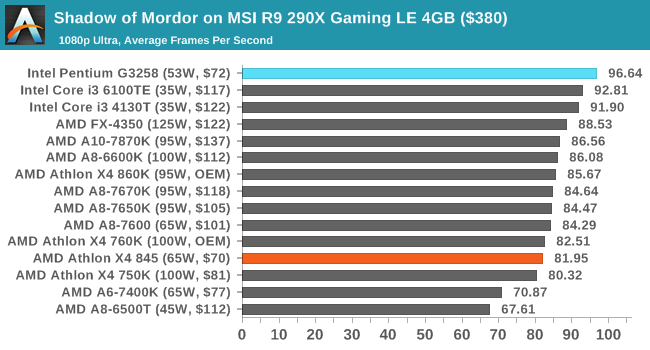
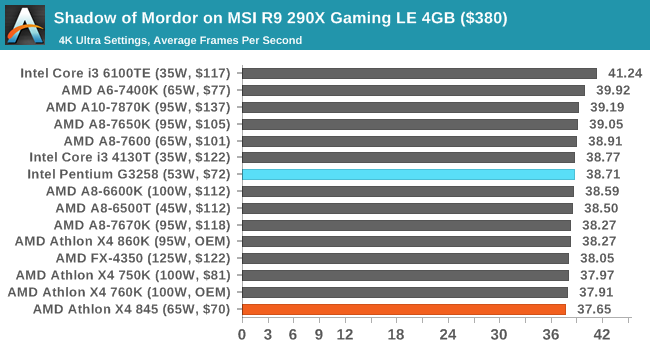
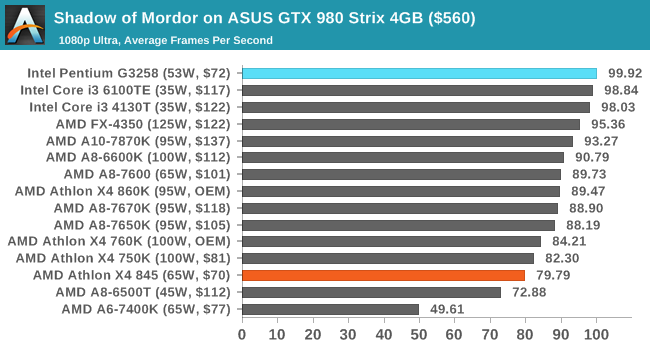
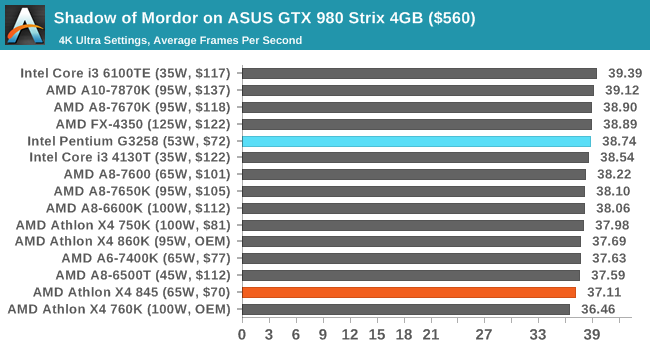
Shadow of Mordor, in all cases except the GTX 770, puts the Pentium ahead of the Carrizo part. In a couple of circumstances, this doesn't matter much, particularly at 4K resolutions with the R9 290X and GTX 980, however at 1080p the Pentium comes out ahead.
![Shadow of Mordor on ASUS R7 240 DDR3 2GB ($70) [Minimum FPS]](https://images.anandtech.com/graphs/graph10436/82717.png)
![Shadow of Mordor on MSI R9 285 Gaming 2GB ($240) [Minimum FPS]](https://images.anandtech.com/graphs/graph10436/82725.png)
![Shadow of Mordor on MSI GTX 770 Lightning 2GB ($245) [Minimum FPS]](https://images.anandtech.com/graphs/graph10436/82735.png)
![Shadow of Mordor on MSI R9 290X Gaming LE 4GB ($380) [Minimum FPS]](https://images.anandtech.com/graphs/graph10436/82745.png)
![Shadow of Mordor on MSI R9 290X Gaming LE 4GB ($380) [Minimum FPS]](https://images.anandtech.com/graphs/graph10436/82747.png)
![Shadow of Mordor on ASUS GTX 980 Strix 4GB ($560) [Minimum FPS]](https://images.anandtech.com/graphs/graph10436/82755.png)
![Shadow of Mordor on ASUS GTX 980 Strix 4GB ($560) [Minimum FPS]](https://images.anandtech.com/graphs/graph10436/82757.png)
Minimum frame rates for Shadow of Mordor are even more in favor of the Pentium here, and with the low-to-mid range graphics cards (R7 240, R9 285, GTX 770) the effect can be up to double the minimum frame rate over the Athlon.











131 Comments
View All Comments
artk2219 - Thursday, July 14, 2016 - link
They had too many parts that weren't hitting their mobile TDP's, or they just bakes too many chips than was needed on the mobile side. Either way, why let them sit in a warehouse or toss them at a loss, when for a very smalla mount you can just throw them into your standard desktop package and make some extra sales.TheinsanegamerN - Thursday, July 14, 2016 - link
Carrizo and kaveri did not use hypertransport. They would have to re-engineer their chip to work on AM3+, and to be frank, the AM3+ market is just too small to justify the tiny margins they would get.That money is better spent on getting zen out of the door.
neblogai - Thursday, July 14, 2016 - link
Why invest into upgrading bad product, when you can sell the same Bulldozer cores till Zen comes? And this Carriso Athlon is just a by-product of a mobile part and can only be sold for desktop. It all makes sense financially. By the way, new Bristol Ridge AMD 15W APUs are really nice and competitive, but laptop manufacturers are failing again- for example, HP Envy x360 comes with FX-9800P APU- again in single channel memory memory configuration, also with HDD installed and without possibility to use SSD. https://hardforum.com/threads/unboxing-1st-impress...TheinsanegamerN - Friday, July 15, 2016 - link
AMD doesnt take the mobile market seriously. If they did, they would be partnering up with the likes of MSI or clevo to produce a good laptop line for their APUs, or at the very least make dual channel a strict requirement.The_Countess - Tuesday, July 19, 2016 - link
AMD unfortunately can't demand much of anything from OEM's currently.and as intel still has a defacto monopoly no OEM wants to piss of intel by making a better AMD laptop.
nathanddrews - Thursday, July 14, 2016 - link
So... will there ever be a desktop Carrizo w/IGP? Much of the hype around Carrizo was focused on its very low power video playback, including H.265 hardware encode/decode.stardude82 - Thursday, July 14, 2016 - link
Isn't that what Bristol Ridge is? But on the new AM3 socket.Arnulf - Thursday, July 14, 2016 - link
AM4.Pissedoffyouth - Thursday, July 14, 2016 - link
Why not bang 8 of these cores into a 125w TDP and make it for FM2+ or AM3+? Finally an upgrade for Piledriver on AM3KAlmquist - Friday, July 15, 2016 - link
If you compare the Athlon 845 with the FX-4350 (link below), the Athlon wins on some benchmarks and loses on others. The Athlon has better IPC, but the FX has a faster clock and a 3rd level cache, leaving no clear-cut winner. If we added an L3 cache to the Athlon chip, that would speed it up, but not by a lot. In other words, Excavator is a big improvement over Piledriver in terms of performance per watt, but not much in terms of absolute performance. An Excavator based FX chip (by which I mean a chip with 8 Excavator cores and 8 MB of L3 cache) would probably be a very marginal improvement over the existing FX lineup at stock frequency, and would have less overclocking potential. I can see why AMD decided not to spend the resources to develop such a chip.http://www.anandtech.com/bench/product/1684?vs=127...